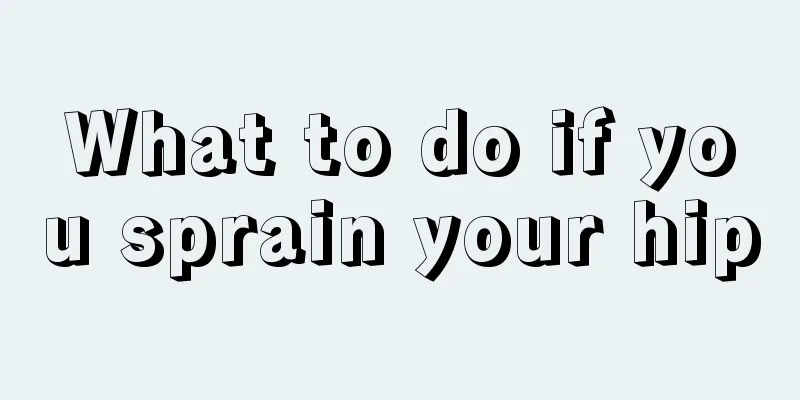What to do if you sprain your hip

|
The hip bone is a relatively important bone in the human body. It is mainly located on both sides of the thigh and has a great influence on people's walking and standing postures. Of course, the hip bone is also more prone to problems. For example, if it is hit by external force, it is very likely to sprain the hip bone. So, what should you do if you sprain your hip? This will be introduced below! 1. Phase 1—Rest, Ice, Compression, Elevation (RICE) RICE can be said to be the general rule for first aid for all sports injuries. (1) Rest: Stop moving the affected area immediately upon injury; (2) Ice compress: Then, ice compress can cause local blood vessels to contract, thereby inhibiting subcutaneous bleeding and reducing inflammation and swelling; (3) Compression: Wrapping the affected area with an elastic bandage can also help reduce swelling, but be sure not to tie it too tightly to avoid blocking blood circulation; (4) Elevate: Elevating the affected area can promote blood and lymph circulation, prevent congestion and reduce swelling. 2. Phase 2 – Limited Activities After completing the first aid and swelling reduction procedures, the next step is to turn the focus to healing the affected area. First, we must understand the role that blood plays in the healing of the affected area. The white blood cells in the blood have the function of defending against bacteria, removing necrotic tissue, and enhancing the body's immunity. Therefore, the time it takes for the affected area to recover is directly proportional to the blood supply. For example, the skin and muscles have dense microvascular tissue, so the recovery period is shorter; but the microvascular distribution of ligaments and tendons is sparse, so it takes at least six weeks to heal; as for the cartilage that protects the joints, since it has no blood supply at all, it can only be cured by surgery. In addition to the density of blood vessel distribution, the amount of exercise will also affect the degree of blood circulation. In the early stages of recovery, the affected area cannot withstand strenuous exercise, so hot compresses or massage are recommended to promote blood circulation. However, when the injured tissue is relatively sound and the affected area no longer feels stinging when used, you can enter the second stage, which is to promote blood circulation through moderate exercise. The so-called moderation means that the affected part can move within the normal range autonomously (without pressure) without feeling discomfort. 3. The third stage - gradual pressure When the affected part is able to move within its own range without feeling pain, pressure is applied to the injured tissue, strengthening it. However, the intensity of pressure must be moderate and should be stopped once pain is felt, otherwise secondary injury will be caused. Secondly, it should be noted that when performing stress resistance training on the affected area, hot compresses should be avoided within 12 hours after training. In addition, this stage can also be used to correct the unbalanced development of muscle groups and strengthen the originally weaker parts by applying pressure. 4. The fourth stage - healing of the affected area With the completion of the third stage, the affected part will recover 2/3 of its original muscle strength, and actual climbing can now be used to help healing. Since the affected area has not been used for a long time, it needs to go through a period of readaptation before it can work in coordination with other muscle groups. At first, you can do some easy, low-intensity climbing training to allow the affected part to adapt to various postures and movements, and then gradually increase the intensity. Compared with the third stage, this stage can help contestants review their own climbing skills. If you tend to climb with fixed movements or on specific terrains, diversified climbing training at this stage will reduce the likelihood of the same type of injury occurring again. |
<<: Stool contains black particles
Recommend
These are the three acupuncture points for treating tinnitus
As they grow older, more and more elderly people ...
How to recover from radial nerve injury?
The radial nerve is in the lower middle 1/3 of th...
10 diseases that can be cured with a hair dryer
When talking about hair dryers, the first thing t...
Tips for preventing rice from insects
If rice is stored at home for too long, it is eas...
4 years after left breast cancer, right breast cancer reappeared
4 years after the left breast cancer, the right b...
What are the sequelae of nasopharyngeal carcinoma
Nasopharyngeal carcinoma is a malignant tumor dis...
Smoking increases the risk of biochemical recurrence after prostate cancer surgery
Smoking is a risk factor for many tumors, but it ...
Can carrots reduce milk production?
Carrot is a vegetable that many people like to ea...
The efficacy and function of Chu Stone
I believe that anyone who studies metal materials...
With these symptoms, it may be nasopharyngeal cancer
Nasopharyngeal cancer is a serious disease, but i...
Bone tumor patients should keep in mind the diet
A good diet can help bone tumor patients improve ...
Why do pineapples need to be soaked in salt water
Pineapple is a kind of fruit that comes into the ...
Can laryngeal cancer be transmitted by laryngoscopy?
Generally speaking, viruses are contagious, but t...
My eyes hurt and my head hurts
Many people often feel eye pain, especially when ...
Is white porcelain tea set poisonous?
Nowadays, many people like to drink tea in their ...









